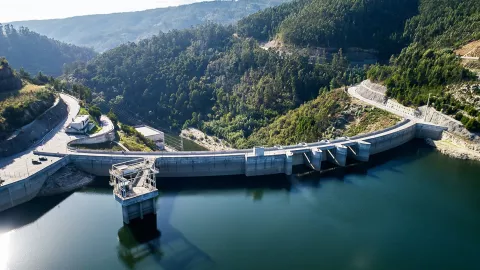The difficulty for fish to cross the barrier created by a dam remains one of the main challenges faced in the effort to mitigate the impact generated by fluvial discontinuity.
Hydraulic infrastructures such as reservoirs and dams split up watercourses and make it impossible for migrations of different species of ichthyofauna, preventing the genetic flow among the subpopulations. Consequently, they induce the respective loss of genetic biodiversity. In the specific case of migratory species, whether they migrate between the river and the sea (diadromous migratory species) or only move within the freshwater environment, interruption of the river continuum flow can promote the loss of habitats, preventing access to areas of food and / or reproduction that are essential to the life cycle of the species.
In the case of the Baixo Sabor Hydroelectric Plant, located in the Trás-os-Montes and Alto Douro region, in the middle of RN2000, this type of effect occurs exclusively to the species that only move in freshwater, as the migration of diadromous species to the mouth of the Sabor river is currently prevented by the cascade of dams in the Douro river. The potentially affected species are the common barbel (Barbus bocagei) and the northern straight-mouth nase (Pseudochondrostoma duriense). Previous studies confirmed the occurrence of significant breeding migrations from the Valeira reservoir to gravels in the Sabor river.

Creating a replacement habitat
Despite the fact that they are native and relatively abundant species, in a conservation status ranging from least concern to vulnerable in Portugal, both have some relevance to the local economy. A compensation measure was established, with the aim of providing a habitat replacement for the final section of the Sabor River. This river section was used for spawning by these two species but was hampered by the construction of the downstream dam connected to the hydroelectric plant. This measure was carried out between 2008 and 2015 and developed on the Vilariça stream, which is the largest non-dammed tributary of the Valeira reservoir in the vicinity of the Baixo Sabor Hydroelectric Plant. The measure known as “Vilariça Compensation Habitat” involved the following actions:
- Construction of a pipeline between the downstream reservoir (Feiticeiro) and the Vilariça stream, aiming to increase the volume of water during the reproductive period and increase the flow rate in the terminal part, to promote the attraction of reproductive barbels and nases to the riverside of the Vilariça stream;
- Construction of 6 weirs (2 of stone and 4 of wood) in the last 5 km of the Vilariça stream, in order to create several transposable obstacles where the water flow is more rapid and thus increase the attraction of the specimens of these species.
- Restoration / rehabilitation of the entire riverside system of the Vilariça stream in a 5 km section, including actions to eradicate invasive species, such as Arundo donax and installation and / or multiplication of native species such as Alnus glutinosa, Fraxinus angustifolia or Salix sp.
The Baixo Sabor Hydroelectric Plant's integrated monitoring program incorporated the measures of “Vilariça Compensation Habitat” since 2015, and the results obtained since the start of operations show a significant ecological resilience of the rehabilitated riverside system and the attractiveness of the species to be conserved by the new spawning habitat. These results are evidence of the success of this compensation measure.
